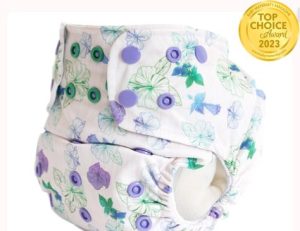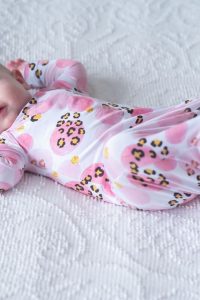As you prepare to welcome your little one, you might be considering venturing into the world of cloth diapering. Newborn Cloth diapers can be a fantastic choice for eco-conscious parents, and using them from the newborn stage offers unique advantages. This guide will explore the world of newborn cloth diapers, providing information on types, benefits, and practical tips to get you started.
Who are Newborn Cloth Diapers For?
Newborn cloth diapers are specifically designed for infants from birth to around 3-4 months old, or until they outgrow the size restrictions. They come in smaller sizes and with features to ensure a comfortable fit for your tiny tot.
Types of Newborn Cloth Diapers
There are several types of newborn cloth diapers available, each with its own set of pros and cons:
Prefolds & Flats:
These are the most economical option. They are rectangular pieces of absorbent fabric that require folding and securing with a diaper cover.
All-in-Ones (AIOs):
These resemble disposable diapers in design and ease of use. They come with built-in absorbency and a waterproof outer layer.
Pocket Diapers:
These have a separate pocket where you insert absorbent inserts. You can adjust the absorbency level by adding more inserts.
Benefits of Newborn Cloth Diapers
Cost-effective:
While there’s an initial investment, cloth diapers can save you money in the long run compared to constantly buying disposables.
Environmentally friendly:
Cloth diapering reduces landfill waste compared to disposable diapers.
Potential for less diaper rash:
Cloth diapers allow for better airflow which can help prevent diaper rash.
Cute and Colorful Designs:
Many cloth diapers come in adorable prints and fun colors.
Things to Consider Before You Begin
Laundry Routine: Cloth diapering requires a dedicated laundry routine. Be sure you have the time and resources to properly wash and store your diapers.
Learning Curve: There’s a bit of a learning curve with cloth diapering, especially when it comes to fitting and using different types.
Lifestyle Compatibility: Consider your lifestyle and whether cloth diapering fits into your daily routine.
Getting Started with Newborn Cloth Diapers
If you’re ready to give newborn cloth diapers a try, here are some tips:
Start Small:
You don’t need a huge stash right away. Begin with a few diapers of each type to find what works best for you and your baby.
Invest in Quality Materials:
Choose diapers made from soft, breathable fabrics like organic cotton.
Prepare Your Laundry Routine:
Research proper washing procedures to maintain hygiene and prevent leaks from buildup.
Join the Community:
Connect with other cloth diaper parents online or in your local area for support, tips, and troubleshooting.
The most important thing is to choose diapering solutions that work best for you and your baby. Don’t be afraid to experiment with different types of cloth diapers to find the perfect fit, and don’t hesitate to reach out to other parents for guidance. Happy cloth diapering!
Essential Newborn Cloth Diapering Supplies
Once you’ve decided to give newborn cloth diapering a try, you’ll need to gather some essential supplies:
Diapers: As mentioned earlier, start with a small stash of different types of newborn cloth diapers (prefolds, AIOs, or pockets) to find your preference.
Diaper Covers: If you choose prefolds or flats, you’ll need waterproof diaper covers to prevent leaks.
Fasteners: Prefolds and flats require fasteners like pins or snappis to secure them around your baby.
Liners (Optional): Consider using disposable liners for easier cleanup, especially for messy poops. These liners can be thrown away with the waste, while the cloth diaper itself goes in the laundry hamper.
Wet Bag: A wet bag is a waterproof bag designed to store soiled cloth diapers until laundry day.
Spray Bottle (Optional): A spray bottle filled with clean water can be helpful for rinsing off waste before tossing diapers in the wet bag or pail.
Diaper Rash Cream: Cloth diapers allow for better airflow, but diaper rash can still occur. Keep a gentle diaper rash cream on hand.
Putting It All Together: A Newborn Cloth Diapering Routine
Here’s a general overview of what a newborn cloth diapering routine might look like:
Change Time: Lay your baby down on a changing pad and remove the soiled diaper. Place it in your wet bag or pail.
Cleaning Up: Wipe your baby’s bottom with gentle wipes or warm water and pat dry. Apply diaper rash cream if needed.
Preparing the New Diaper: If using prefolds or flats, fold them according to your preferred method and secure them with a diaper cover and fasteners.
For AIOs or pockets, simply put the diaper on your baby like a disposable diaper.
Fastening and Adjusting: Ensure a snug but comfortable fit around your baby’s legs and waist to prevent leaks.
Laundry Day! Once your diaper pail is full, or every other day, wash your cloth diapers according to the manufacturer’s instructions.
Troubleshooting Common Newborn Cloth Diapering Issues
Even the most prepared parents will encounter challenges with cloth diapering. Here are some common issues and solutions for newborn cloth diapers:
Leaks:
Leaks can happen for several reasons. Ensure a proper fit around your baby’s legs and waist. Check for damaged elastics or loose fasteners on prefolds or covers. You might need to adjust absorbency by adding inserts to pocket diapers.
Blowouts:
Newborn poop explosions are inevitable! If you experience frequent blowouts, consider using disposable liners for easier cleanup. A well-fitting diaper with enough absorbency can also help contain messes.
Diaper Rash:
While cloth diapers can help reduce diaper rash, it can still occur. Stick to a regular diaper rash care routine, including frequent changes, cleaning with warm water and gentle products, and allowing for air dry time.
Washing Woes:
Building up laundry can be overwhelming. If you find yourself struggling to keep up, consider adding a few more diapers to your stash or doing smaller loads more frequently. Remember to follow washing instructions carefully to maintain hygiene and prevent leaks from buildup.
Cloth Diapering on the Go
Venturing out with a newborn and cloth diapers requires some extra planning:
Packing for Outings: Pack a wet bag for soiled diapers and enough clean diapers to last your trip. Bringing along a small changing pad can also be helpful.
Diapering Discreetly: Many public restrooms have baby changing stations with disposal bins. If you’re breastfeeding, consider nursing your baby before heading out to minimize diaper changes during your trip.
Back-Up Options: It’s always a good idea to pack a few disposable diapers in your diaper bag in case of emergencies or leaks.



